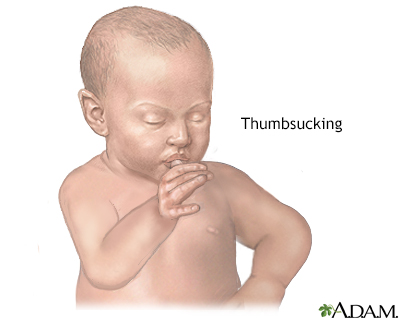Thumb sucking
Many infants and children suck their thumbs. Some even start sucking their thumbs when they are still in the womb.
Thumb sucking can make children feel secure and happy. They may suck their thumbs when they are tired, hungry, bored, stressed, or when they are trying to calm down or fall asleep.
Images


I Would Like to Learn About:
Information
Do not be too concerned if your child sucks his thumb.
Do not punish or nag your child to make them stop. Most children stop sucking their thumb on their own, by the time they are 3 to 4 years old. They grow out of sucking their thumb and find other ways to comfort themselves.
Older children most often stop from peer pressure at school. But if your child feels pressured to stop, they may want to suck their thumb more. Understand that sucking their thumb is how your child calms and comforts themselves.
It is OK for children to suck their thumb until their adult teeth start coming in, at around age 6. Damage to the teeth or the roof of the mouth seems to happen more if a child sucks hard. If your child does this, try to help them stop sucking their thumb by age 4 to prevent damage.
If your child's thumb gets red and chapped, put cream or lotion on it.
Help your child stop thumb sucking.
Know that it is a hard habit to break. Start talking to your child about stopping when they are 5 or 6 years old and you know their adult teeth are coming in soon. Also, give help if thumb sucking embarrasses your child.
If you know when your child most often sucks their thumb, find other ways for your child to find comfort and feel secure.
- Offer a toy or a stuffed animal.
- Put your child down for a nap earlier when you notice they are getting sleepy.
- Help them talk out their frustrations instead of sucking on their thumb to calm down.
Give support to your child when they try to stop sucking their thumb.
Praise your child for not sucking their thumb.
Ask your child's dentist or health care provider to talk to your child about stopping and to explain the reasons to stop. Also, ask your child's providers about:
- Using a bandage or thumb guard to help your child.
- Using dental appliances if your child's teeth and mouth have been affected.
- Placing a bitter nail polish on the thumb nail. Be careful to use something that is safe for your child to consume.
References
American Academy of Pediatrics. Healthychildren.org website. Pacifiers and thumb sucking. www.healthychildren.org/English/ages-stages/baby/crying-colic/Pages/Pacifiers-and-Thumb-Sucking.aspx. Updated November 29, 2020. Accessed July 26, 2023.
Baumhardt H, Chapman M, D'Alesio A, Woods K. Oral disorders. In: Zitelli BJ, McIntire SC, Nowalk AJ, Garrison J, eds. Zitelli and Davis' Atlas of Pediatric Physical Diagnosis. 8th ed. Philadelphia, PA: Elsevier; 2023:chap 21.
Ryan CA, Walter HJ, DeMaso DR. Motor disorders and habits. In: Kliegman RM, St. Geme JW, Blum NJ, Shah SS, Tasker RC, Wilson KM, eds. Nelson Textbook of Pediatrics. 21st ed. Philadelphia, PA: Elsevier; 2020:chap 37.
BACK TO TOPReview Date: 7/1/2023
Reviewed By: Charles I. Schwartz, MD, FAAP, Clinical Assistant Professor of Pediatrics, Perelman School of Medicine at the University of Pennsylvania, General Pediatrician at PennCare for Kids, Phoenixville, PA. Also reviewed by David C. Dugdale, MD, Medical Director, Brenda Conaway, Editorial Director, and the A.D.A.M. Editorial team.

Health Content Provider
06/01/2025
|
A.D.A.M., Inc. is accredited by URAC, for Health Content Provider (www.urac.org). URAC's accreditation program is an independent audit to verify that A.D.A.M. follows rigorous standards of quality and accountability. A.D.A.M. is among the first to achieve this important distinction for online health information and services. Learn more about A.D.A.M.'s editorial policy, editorial process and privacy policy. A.D.A.M. is also a founding member of Hi-Ethics. This site complied with the HONcode standard for trustworthy health information from 1995 to 2022, after which HON (Health On the Net, a not-for-profit organization that promoted transparent and reliable health information online) was discontinued. |
The information provided herein should not be used during any medical emergency or for the diagnosis or treatment of any medical condition. A licensed medical professional should be consulted for diagnosis and treatment of any and all medical conditions. Links to other sites are provided for information only -- they do not constitute endorsements of those other sites. © 1997- 2024 A.D.A.M., a business unit of Ebix, Inc. Any duplication or distribution of the information contained herein is strictly prohibited.
